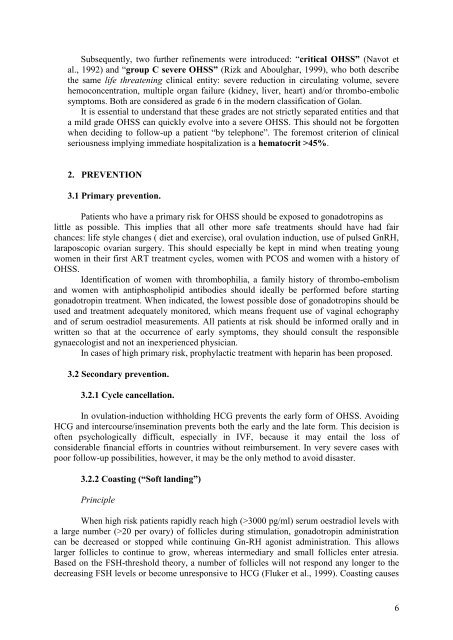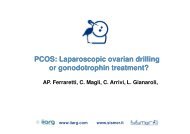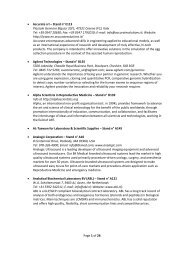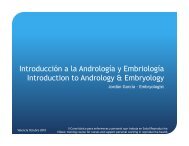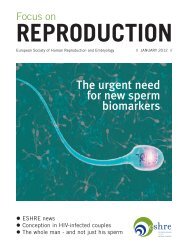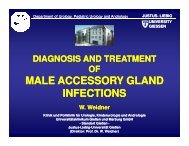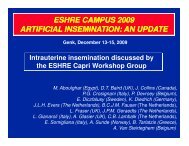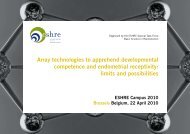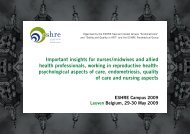Ovarian Hyperstimulation Syndrome - eshre
Ovarian Hyperstimulation Syndrome - eshre
Ovarian Hyperstimulation Syndrome - eshre
Create successful ePaper yourself
Turn your PDF publications into a flip-book with our unique Google optimized e-Paper software.
Subsequently, two further refinements were introduced: “critical OHSS” (Navot etal., 1992) and “group C severe OHSS” (Rizk and Aboulghar, 1999), who both describethe same life threatening clinical entity: severe reduction in circulating volume, severehemoconcentration, multiple organ failure (kidney, liver, heart) and/or thrombo-embolicsymptoms. Both are considered as grade 6 in the modern classification of Golan.It is essential to understand that these grades are not strictly separated entities and thata mild grade OHSS can quickly evolve into a severe OHSS. This should not be forgottenwhen deciding to follow-up a patient “by telephone”. The foremost criterion of clinicalseriousness implying immediate hospitalization is a hematocrit >45%.2. PREVENTION3.1 Primary prevention.Patients who have a primary risk for OHSS should be exposed to gonadotropins aslittle as possible. This implies that all other more safe treatments should have had fairchances: life style changes ( diet and exercise), oral ovulation induction, use of pulsed GnRH,laraposcopic ovarian surgery. This should especially be kept in mind when treating youngwomen in their first ART treatment cycles, women with PCOS and women with a history ofOHSS.Identification of women with thrombophilia, a family history of thrombo-embolismand women with antiphospholipid antibodies should ideally be performed before startinggonadotropin treatment. When indicated, the lowest possible dose of gonadotropins should beused and treatment adequately monitored, which means frequent use of vaginal echographyand of serum oestradiol measurements. All patients at risk should be informed orally and inwritten so that at the occurrence of early symptoms, they should consult the responsiblegynaecologist and not an inexperienced physician.In cases of high primary risk, prophylactic treatment with heparin has been proposed.3.2 Secondary prevention.3.2.1 Cycle cancellation.In ovulation-induction withholding HCG prevents the early form of OHSS. AvoidingHCG and intercourse/insemination prevents both the early and the late form. This decision isoften psychologically difficult, especially in IVF, because it may entail the loss ofconsiderable financial efforts in countries without reimbursement. In very severe cases withpoor follow-up possibilities, however, it may be the only method to avoid disaster.3.2.2 Coasting (“Soft landing”)PrincipleWhen high risk patients rapidly reach high (>3000 pg/ml) serum oestradiol levels witha large number (>20 per ovary) of follicles during stimulation, gonadotropin administrationcan be decreased or stopped while continuing Gn-RH agonist administration. This allowslarger follicles to continue to grow, whereas intermediary and small follicles enter atresia.Based on the FSH-threshold theory, a number of follicles will not respond any longer to thedecreasing FSH levels or become unresponsive to HCG (Fluker et al., 1999). Coasting causes6


